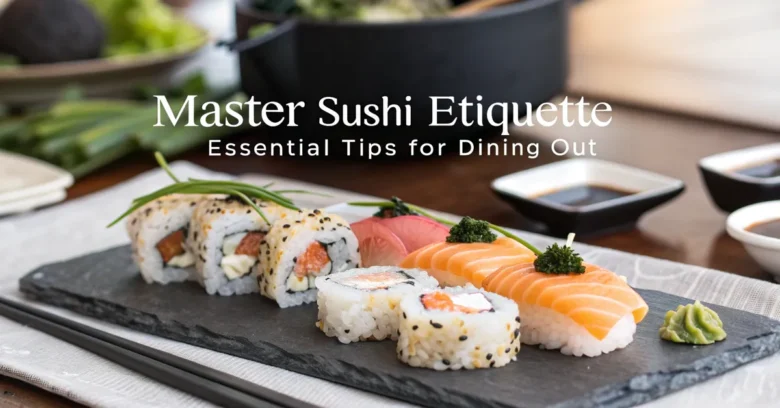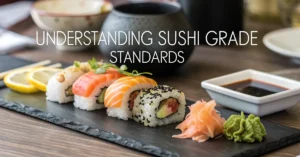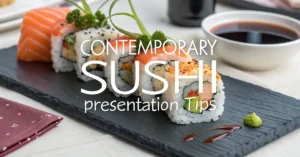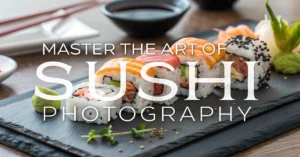Imagine stepping into a sushi restaurant for the first time. The sleek wood, the rhythmic chopping sounds, the tantalizing aroma of rice vinegar – it’s an experience! But amongst all this, a question might bubble up: Am I doing this right? Sushi, beyond being a delicious meal, comes with its own set of customs. Knowing the proper sushi etiquette isn’t about being pretentious; it’s about showing respect for the chef, the ingredients, and the dining experience itself.
This guide is your friendly companion to navigate the world of sushi etiquette. We’ll explore the essential tips to make your next sushi outing smooth and enjoyable. Think of it as a way to elevate your dining experience, to truly savor the art and craft that goes into each perfect bite.
Navigating the Sushi Scene: Essential Etiquette Tips
Know Your Chopsticks: Mastering the Basics
Chopsticks, or hashi, are more than just utensils; they’re an extension of your hand in Japanese cuisine. Using them correctly is a fundamental aspect of sushi etiquette.
-
Holding them right: Grip the chopsticks about one-third of the way down. The top chopstick should move like a pen, while the bottom one remains stationary, resting in the crook of your thumb.
-
Resting place: When not in use, place your chopsticks on the chopstick rest (hashioki). Never lay them directly on the table or across your bowl.
-
Forbidden actions: Certain actions with chopsticks are considered impolite. Avoid the following:
- Sticking chopsticks upright in your rice: This resembles a ritual offering to the dead.
- Passing food directly from chopstick to chopstick: This mimics a funeral ritual.
- Spearing food: Use your chopsticks to gently lift the sushi.
- Waving your chopsticks or using them to point.
- Licking your chopsticks.
-
What if you are left-handed?: Don’t be afraid to ask for left-handed chopsticks. If none available, it is completely acceptable to use the chopsticks as best as you can, without feeling pressured to switch to your non-dominant hand if you aren’t familiar.
Soy Sauce Savvy: Dipping Dos and Don’ts
Soy sauce, or shoyu, is a key condiment, but using it properly enhances, rather than overwhelms, the sushi’s flavor.
-
Pouring: Don’t drown your soy sauce dish. Pour a small amount; you can always add more.
-
Dipping: The general rule is to dip the neta (the topping) into the soy sauce, not the shari (rice). Dipping the rice can cause it to fall apart and become overly salty. Some nigiri are best consumed without any soy sauce at all.
-
Wasabi’s role: Wasabi is often provided. You can either add a tiny amount directly to the neta or mix a small amount into your soy sauce. However, be mindful not to overdo it. Many chefs already place wasabi between the rice and fish, so adding more might be excessive.
-
Ginger as a palate cleanser: The pickled ginger, or gari, isn’t meant to be eaten with the sushi. Instead, use it as a palate cleanser between different types of sushi to refresh your taste buds.
Ordering Insights: A Guide to Navigating the Menu
The sushi menu can be intimidating for newcomers. Understanding a few key terms and ordering strategies can make the experience more enjoyable.
-
Nigiri: Sliced fish (or other topping) atop a bed of vinegared rice.
-
Sashimi: Slices of fish served without rice.
-
Maki: Sushi rolls, typically with seaweed (nori) on the outside.
-
Temaki: Cone-shaped hand rolls.
-
Omakase: “I’ll leave it to you.” Opting for omakase means trusting the chef to select the best and freshest offerings of the day. This is a great way to experience a variety of flavors and textures.
-
Ordering progression: If you’re not going with omakase, consider ordering lighter, milder fish first, progressing to richer, more flavorful options. This allows you to appreciate the nuances of each type.
-
Ask questions: Don’t hesitate to ask your server or the chef about the different types of fish or preparations. It’s a sign of genuine interest and can lead to a more informed and satisfying meal.
The Art of the Bite: Size Matters
Sushi is designed to be eaten in one bite, allowing all the flavors to meld harmoniously.
-
One-bite rule: Resist the urge to cut a piece of sushi in half. Trust the chef’s preparation and enjoy it as intended.
-
Turning nigiri: If you’re dipping nigiri in soy sauce, turn it upside down so the fish touches the sauce first. This prevents the rice from soaking up too much soy sauce and falling apart.
-
Respect the rice: The shari (rice) is just as important as the neta (topping). Appreciate the subtle sweetness and texture of the rice, which is carefully prepared to complement the fish.
Beyond the Plate: Respecting the Environment
Dining at a sushi restaurant is not just about the food, it’s also about respecting the atmosphere and the people around you.
-
Be mindful of noise levels: Keep your voice down and avoid loud conversations. Sushi restaurants are often designed to be serene and contemplative spaces.
-
Avoid strong perfumes or colognes: Strong scents can interfere with the delicate aromas of the sushi.
-
Phone etiquette: Minimize phone use at the table. Give your full attention to the dining experience and the company you’re with.
-
Gratitude: At the end of your meal, express your appreciation to the chef and staff. A simple “arigato gozaimasu” (thank you very much) goes a long way.
Nigiri Know-How: Deeper Dive into Proper Consumption
Let’s focus on nigiri, perhaps the purest expression of sushi, and delve into its proper consumption. As mentioned, dipping the neta in soy sauce is key. However, certain fish, like fatty tuna (otoro), are often best enjoyed without soy sauce, as they already possess a rich, complex flavor. The chef might even brush the nigiri with soy sauce beforehand, indicating that no further dipping is needed. Trust their judgment!
Many sushi aficionados recommend eating nigiri immediately after it’s served. The rice is at its ideal temperature and texture, and the fish is at its freshest. Lingering too long can compromise the experience.
Understanding Wasabi: More Than Just Heat
Wasabi is often misunderstood as simply a source of fiery heat. However, when used correctly, it enhances the flavor of the sushi by cutting through the richness of the fish and providing a subtle counterpoint.
Real wasabi, grated from the wasabi root, has a complex flavor profile that includes sweetness and vegetal notes. Unfortunately, many restaurants use a substitute made from horseradish, mustard, and green food coloring.
Whether you’re using real wasabi or a substitute, moderation is key. A tiny dab is all you need to awaken your palate and complement the fish. Don’t dissolve a large clump of wasabi into your soy sauce; this overwhelms the other flavors and can be seen as disrespectful to the chef’s skill.
Sushi Bar vs. Table: Adapting to the Setting
Sushi restaurants offer two main seating options: the sushi bar and the tables. Each setting has its own nuances of etiquette.
-
Sushi bar: Sitting at the sushi bar allows you to interact directly with the chef, observe their artistry, and receive your sushi immediately after it’s prepared. This is the preferred option for many sushi enthusiasts.
-
Engage respectfully: Feel free to ask the chef questions about the fish, their techniques, or the restaurant’s philosophy. However, avoid being overly chatty or disruptive.
-
Accept recommendations: If the chef offers a recommendation, consider trying it. They are experts in their craft and can guide you towards new and exciting flavors.
-
Tip the chef: It’s customary to tip the chef directly, in addition to the server.
-
-
Tables: Dining at a table offers more privacy and is suitable for larger groups.
-
Pace your meal: Be mindful of the pace of your meal and avoid ordering too much food at once. Sushi is best enjoyed when it’s fresh and not sitting out for too long.
-
Share thoughtfully: If you’re sharing sushi rolls with others, offer the last piece to someone else, rather than taking it yourself.
-
Beyond the Basics: Advanced Etiquette Considerations
For those looking to deepen their understanding of sushi etiquette, here are a few more advanced considerations:
-
Temperature sensitivity: Be aware that the temperature of the sushi rice is carefully controlled. Avoid adding cold drinks or other items directly to the sushi, as this can affect its texture and flavor.
-
Specific toppings: Some sushi comes with specific toppings, such as a brush of sauce or a sprinkle of salt. These are carefully chosen by the chef to enhance the flavor of the fish. Avoid removing or altering these toppings.
-
Oshibori Use: The oshibori (a moist hand towel) is provided for cleaning your hands before you eat. It’s not for wiping your face or neck.
-
Tea service: Green tea is often served with sushi. It’s meant to be sipped slowly throughout the meal, as a palate cleanser and digestive aid.
-
Seasonal awareness: Appreciating the seasonality of ingredients is a hallmark of Japanese cuisine. Ask your server or the chef about the seasonal offerings and choose sushi that features the freshest and most flavorful ingredients.
What if You Make a Mistake? Graceful Recovery
Even with the best intentions, mistakes happen. The key is to handle them with grace and humility. If you accidentally violate a rule of etiquette, simply apologize sincerely and correct your behavior. Most people will appreciate your effort to learn and respect the culture. A simple “Sumimasen” (excuse me) can go a long way.
Remember, sushi etiquette is not about rigid adherence to rules, but about showing respect and appreciation for the art and craft of sushi making. With a little knowledge and a willingness to learn, you can confidently navigate the sushi scene and elevate your dining experience. It’s about honoring the chef’s skill and the freshness of the ingredients.
Enjoy the Experience! It’s More Than Just Food
Ultimately, the goal is to savor the delicious and unique experience that sushi provides. Armed with these insights into sushi etiquette, you can confidently step into any sushi restaurant, not just as a customer, but as an informed and appreciative guest. So, go ahead, explore the menu, ask questions, and enjoy the journey!



